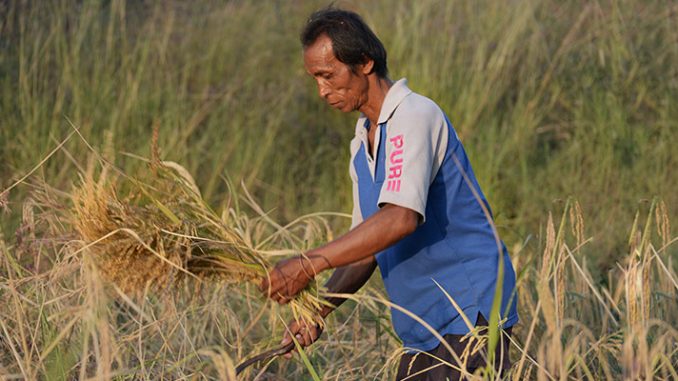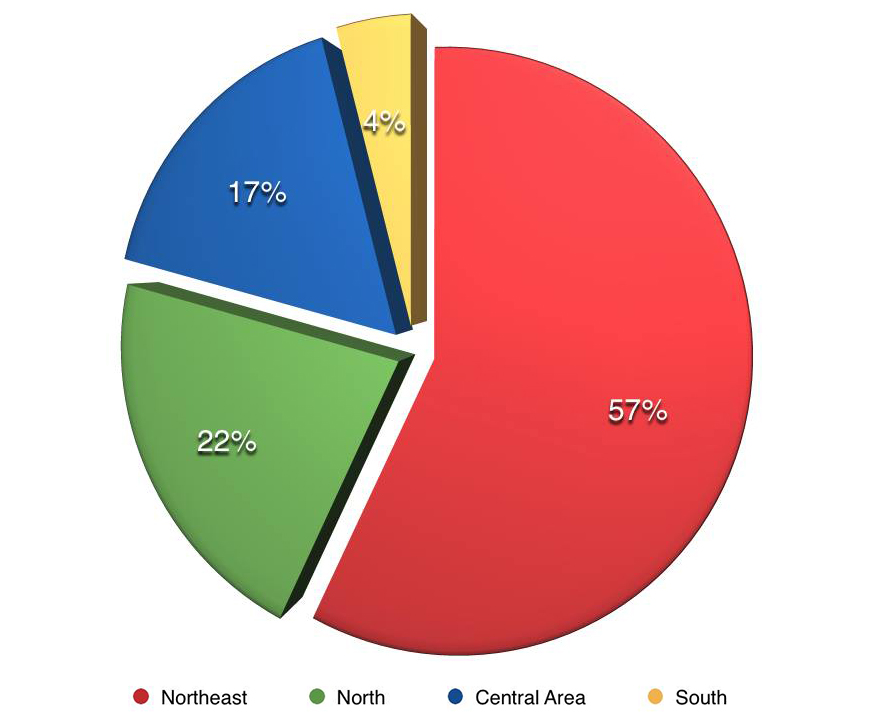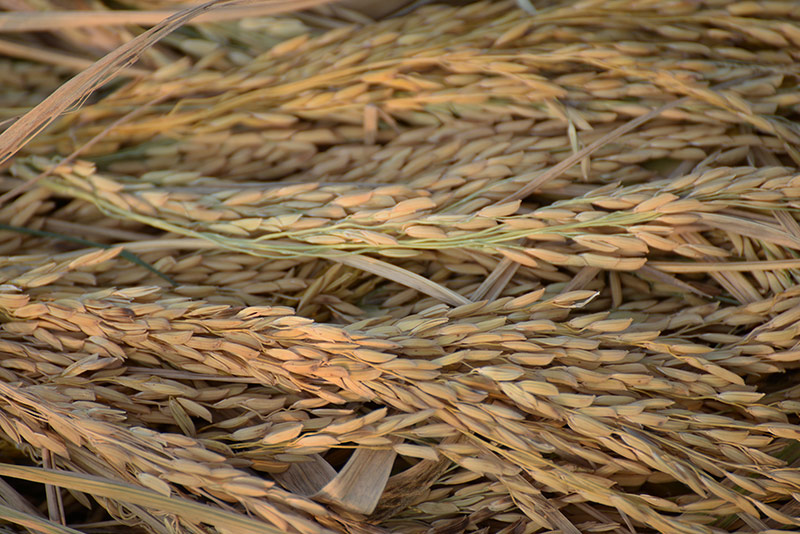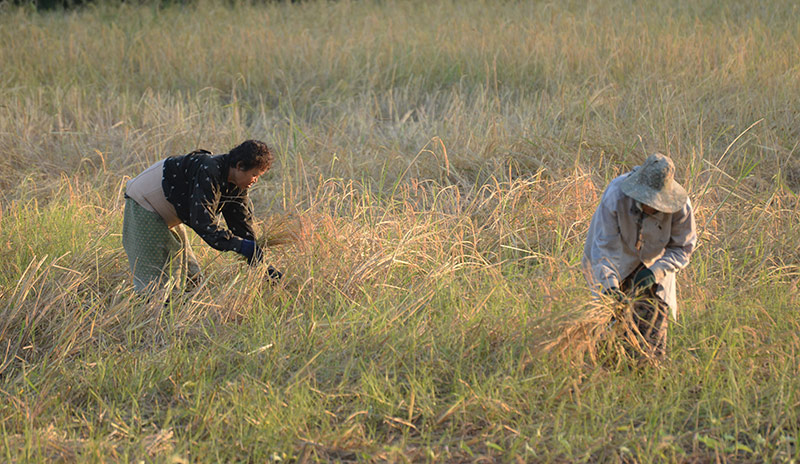
This situational context significantly acts to ensure that such questions, factors, and considerations are, with regard to the possible and likely implications for Thailand, almost inevitably, deeply and inherently politicised, in a rather broad and general sense. Moreover, these problems are, in themselves, intrinsically and deeply implicated in relation to the increasingly dangerous Thai social-political crisis of the past decade, which is only furthered by an increasingly apparent and entrenched societal divide. In terms of this divide, it can to a significant extent, be regarded as one, which delineates between those who remain as rural, provincial, small-scale – and still close to subsistence – agricultural farmers, and those who are increasingly urbanised, educated, middle-class, and also, ‘aspirational’.
Land ownership, corruption and subsidies
One important factor relates to the historical and convoluted question of land rights and land ownership, because this has been an age-old, and seemingly intractable problem within Thailand – the consequence, and also, proximate continuance of historical ‘feudal’ times. Therefore, in terms of agricultural production, and rice production in particular, the political and institutional decision-making – and also, the respective national public debate – is further complicated by this necessarily interrelated factor. There are a number of locally-based NGOs across Thailand, which have been working towards a more equitable, and, many would argue, ‘fairer’ distribution of the land, although relatively little progress has, as of yet, been made. It follows, therefore, that the operation of Thailand’s legal system remains a question of marked significance.
An ever-present, fundamental concern, which must be considered in relation to any examination, is the entrenched and pervasive problem of corruption, within Thailand, because this problem continues to seriously afflict Thai society to this day. According to an in depth study on Thai rice policy, published back in 1975, by Ammar Siamwala, and entitled: “The History of Rice Policies in Thailand”, it was argued that corruption was one of the main obstacles to the effective implementation of rice policies. (Ammar Siamwala, 1975)
Another factor relates to the more general question of rice-subsidies. It continues to be the case, of course, that for many nations, the question of agricultural subsidies is a complex and often somewhat contentious matter; and moreover, that it a profound concern for the farmers of developing nations. With regard to Thailand, its rice farmers, and their relative political rise over the past decade and a half, a correspondence with a problematic Thai social-political divide and increasingly evident societal schism, can hardly be ignored. Notwithstanding this, their seeming, relative, and recent rise was, ultimately, largely based on a rather tenuous set of circumstances – especially because they lacked a proven, autonomously organised, grass-roots impetus, which would be a requisite in the furthering and advancement of their cause. Accordingly, Thai rice farmers remain relatively ineffectual as a demographic, and as an interest group seeking social and economic progress through engagement with the political system, and also, increased influence in relation to the policy-making process.
A shift in policies in May 2014
As a consequence, when the Thai coup d’état of the 22nd of May, 2014 acted to suspend democratic politics within Thailand – and with it, an arguably rather populist democratic mandate, which had implemented a range of policies that were generally favoured by the historically disregarded rural, provincial, agricultural demographics – rice farmers lost much of the ground, so to speak, which they had, seemingly, gained over recent years. This relates, in particular, to the relatively generous rice subsidies, which had acted to almost double the incomes of many small-scale rice farmers.
In recognising this general context, we can then begin, rather quickly, to observe and evince just how interconnected these various problems are. For they bring to the forefront a number of pertinent issues, including: the question of the extent of the free-market in relation to agricultural production within developing nations; political instability and polarisation; socio-economic disparities; historical social and societal injustices; state involvement (or interference) in ‘strategic’ staple agricultural production (not only for meeting domestic demand, but, with Thailand remaining as one of the world’s leading rice exporters, an important source of foreign currency reserves); the context of a developing nation, such as Thailand, and its current ‘non-democratic’ political status; the test as to whether such a nation can establish and retain a functioning, efficacious political system, with its independent branches (executive, legislature, judiciary) – all of which are brought into question, when the tenability of the current overall direction is, in itself, increasingly being questioned.
Thailand’s rice belts
Today, across Thailand, rural, provincial rice-farmers are relatively open in learning to develop their local-level knowledge with regard to ‘organic’ production methods. However, water supply problems and shortages, and especially the droughts in summer, were problems, historically; and this more typically meant that only one harvest would be possible, per year – except within the most fertile areas of the “Northern Region” and the “Southern Region”, and also, within the “Central Region”, close to Bangkok, where the infrastructure for irrigation was more advanced. Although all these regions remain as areas for significant rice production, it is the case of the “Northeastern Region”, which is of particular note here, because, as a case-study, it is so pertinent in a number of important respects.

Source: Rice Department, Ministry of Agriculture and Cooperatives, Thailand
The Northeast region, otherwise known as ‘Isan’, has been historically, and remains as the main area for rice production, within Thailand, today. Indeed, according to the most recent statistics available from the Thai Ministry of Agriculture and Cooperatives, Isan accounted for 57 percent of the land dedicated to rice cultivation. (See Figure 1.) Moreover, although the various competing claims relating to the quality of rice production across Thailand do continue to be argued over, it is notable that of the rice that is highly sought after according to quality – with respect to Thai consumers, Thai exporters, and export markets – it is the rice that is produced within the provinces of Isan, which is continually, and most principally in demand.
However, in many other respects, this region remains generally marginal in economic and social developmental terms, and the provinces of this region are – according to both experience, and a range of measures – generally regarded as some of the poorest within Thailand. According to the National Statistic Office of Thailand, in 2012, the per capita income of the population of Isan was 67,888 baht, whilst the overall Thai (“Whole Kingdom”) per capita income was 183,803 baht. (See Figure 2.) Because the quality of the rice production of Isan is often regarded as being of the highest of Thai standards, it is arguable that much of this rice could, at least in principle, compare favourably with almost any rice produced internationally, and, therefore, command a premium for its farmers. However, an external oversight for quality assurance is generally lacking – especially in relation to chemical usage – and, therefore, an internationally recognised certification for ‘organic’ production status, is attained, only relatively rarely.

Source: National Statistical Office (2014), Ministry of Information and Communication Technology, Thailand
It is generally the case within Thailand that – at least in relation to agricultural products that have either a general, or a particular value as commodities on the international markets – small-scale farmers already have, to a certain extent, an understanding of the challenge posed by the market, as well as the need to retain or develop some autonomy in relation to these forces. This is essentially the case now, with respect to Thai rice farmers; and in addition, because of the recognised quality of Thai rice production, they, perhaps, ought to be in a better position than they currently are, to assert themselves, accordingly. In principle, with their healthy surplus of production, their ‘food sovereignty’, so to speak, should not be a question, as such. However, their increasing, relative indebtedness is a growing cause for concern, as is their reliance on, and adaption to the price that they receive for their rice, which may significantly diverge from both the basic commodity market price, and the price paid by consumers – but, these are hardly new concerns in relation to agricultural production, within developing nations.

Satisfying overseas markets
With regard to small-scale rice farmers, and how they relate to, and integrate into the global rice-market, as a general consequence of increasing ‘globalisation’, a number of Thai rice farmer groups have been working increasingly closely with exporters. This includes an increased consideration for international production standards, and although not, yet, typically meeting or matching European Union, U.S., or Japanese standards of ‘organic’ certification, Thai production is, indeed, improving. It is true that the term ‘organic’ does, within Thailand, remain loosely defined, and also, loosely applied. Nevertheless, the future broad attainment to such standards would not only be desirous for Thailand, but, also, would be relatively straightforward – were it not for a number of continual, aggravating obstacles.
These obstacles relate to: the tenuousness of the price of the rice that small-scale farmers can obtain; uncertainty surrounding rice subsidies as a likely consequence of political factors; the continued trend towards seasonal economic migration – especially from Isan (which has the lowest per capita income of any of the regions of Thailand) to Bangkok and the Central Region of Thailand (see Figure 2 and its reference to the “Northeastern Region”, “Bangkok and Vicinities”, and the “Central Region”); the positional advantage held by rice-mill owners within the Thai rice market – and, therefore, the challenge in permanently transitioning to ‘organic’ production, within such a context. Accordingly, it is evident that these factors undermine the establishing of conditions more conducive for the additional investment and other such efforts, which would make an internationally respected ‘organic’ standard more attainable for the small-scale Thai rice farmers.
In the case of Thailand, therefore, the question could well be raised: “How far can we go to support small-scale rice farmers, in order that they might have more negotiating power – not only in relation to their ability to pressure policy-makers to more effectively respond to their reasonable demands, but also, with regard to their ability to attain a more commensurate price for their rice?”
It can reasonably be argued that the influence of the more rigorous policies relating to international food quality and safety standards – such as those coming from the E.U., the U.S., and Japan, in particular – can assist to improve the quantity and quality of organic production, and thereby improve the standards, which are demanded and expected of Thai production, overall. According to general observations of organic production within Thailand, it is the case that both small-scale and large-scale farmers, alike – including rice farmers – still typically adopt and utilise the term ‘organic’, somewhat loosely. From their perspective, ‘organic’ production is neither defined by, nor is it strictly equated with produce that is absolutely free of chemical substances, and instead, it is more commonly defined as a supposed ‘minimum’ use of chemical substances, in relation to their production. Therefore, the stricter standards, which are demanded by international markets, will, in the long term, likely be a significant catalyst for small-scale farmers within Thailand, in encouraging them to become increasingly focused on both the promise and the benefits of attaining to ‘organic’ production methods, and standards.
Currently, one of the main strategic weaknesses, and, therefore, concerns, for the small-scale Thai rice farmers who are otherwise open to ‘organic’ production, relates to the fact that most of the ‘organic’ production – and also, the market in relation to it – is already, principally under the control of large-scale businesses and investors. Moreover, this disadvantageous circumstance is now further compounded by their relative political weakness, at a time when rice subsidies are no longer favourable, when the decision-making process (in a post-coup d’état non-democratic state mechanism) is no longer so responsive to the small-scale rice farmers as a political demographic, and when these farmers have remained, proportionately, both politically and economically, rather weak.
Labour issues
For small-scale rice farmers and the wider rural population of Isan, the level of seasonal migration remains high during the summer time; and this is most especially because the water supply is limited at this time, and with the additional problem of the quality and fertility of these agricultural soils, a second rice harvest is often impossible. Therefore, the question of moving to work in factories or in the construction industry, within Bangkok or its nearby provinces, became, over recent decades, an imperative – and this still remains the case for many. Nevertheless, it is of course the case that if the reliability of the water supplies, and the quality of the agricultural soils were to be improved, then this would act to support an increased sense of self-sufficiency within rural, provincial Thailand. The general sentiment remains a strong indicator that the local populations will be motivated to stay within their provinces, if it is economically sustainable for them to do so.

Today, many of the generational, small-scale rice farmers are no longer completely dependent on income from their farms; now, alternative sources of income, including that from seasonal labour migration, or remittances from the younger generations who often work within the industrial sector, increasingly assist in the supporting of rural, provincial farming families, and their communities. Therefore, a comprehensive re-examination of the underlying structure of Thailand’s ‘rice economy’ would be a critically important consideration, in attempting to more effectively reconsider the role of the Thai state, in relation to so much of this.
Over the coming years and decades, it is likely that the Thai agricultural sector will, increasingly, experience a general labour shortage – primarily because the younger generations tend not to perceive that working within this sector will provide for a financially secure future. Inevitably, therefore, it will prove necessary to reexamine the role of the state in relation to this sector, which remains strategically and structurally so important to Thailand; socially, politically, and economically. This is, not least of all, because the relationships between the various stakeholders are often decidedly ambivalent. Key considerations include: the influence of the state, the problem of corruption, and the demands and expectations of the overall Thai population; and these are factored in relation to the market price of rice and other staple products, the role of rice subsidies, and the concerns of a rural, provincial population – which may often feel betrayed by the state, be exploited by rice-mill owners, and also, find themselves at odds with the millions of Thais who continue to critique their recent role in Thai politics.
Measuring up to the EU
Within the E.U., it is argued that farmers will not be able to continue without the support of both the E.U., and their respective national governments. Over a number of decades, the E.U. has adopted different policy instruments, in order that their farmers can, ultimately, compete and survive in both the domestic and international markets – none of which can be regarded as the ‘free market’. The Common Agricultural Policy (CAP) of the E.U. remains as a policy of heavy subsidisation, despite ongoing attempts at reform. According to a recent report by the E.U.: “For more than twenty years, starting in 1992, the CAP has been through successive reforms which have increased market orientation for agriculture while providing income support and safety net mechanisms for producers, improved the integration of environmental requirements and reinforced support for rural development across the EU.” (European Union, 2013) In addition, the CAP is also continuing with an attempt to encourage younger generations to work within the farming sector, by providing income support for “young farmers”, in order to sustain agricultural production within the E.U.
Notwithstanding the various ways in which Thai rice production is politicised – to the detriment of small-scale rice farmers – the agricultural sector, worldwide, remains a highly politicised sector, at both the national and international levels of consideration. The ongoing Doha Round of the World Trade Organisation (WTO), which began in November 2001, has yet to conclude with an agreement, and it is the agricultural sector, which is proving to be the main issue. Indeed, the E.U. have highlighted, that: “Agriculture is a cornerstone of the Doha Round, not least because of the level of developing countries’ involvement. Negotiations on agriculture cover three areas or pillars: domestic support (subsidies), market access (import regime, including tariffs), and export competition (export refunds, export credits, food aid and state-trading enterprises).” (European Union, 2015)
Long-term strategic policy
Although Thailand is not one of the top spenders on agricultural subsidies – unlike the E.U., the U.S., and Japan – Thailand, like so many other countries, has been forced to recognise that state intervention within the agricultural sector will be increasingly subject to greater external pressures and influence; and not least of all, the rules and regulations of the WTO. This is why a long-term strategic policy framework for the Thai agricultural sector, must act to support Thai farmers, in order that they can be truly competitive in relation to the international market – and this means a recognition of the market mechanism, rather than a reliance on state interference. Therefore, in order to realise a more effective long-term strategy in relation to important matters such as ‘rice policy’, it is incumbent on Thai policy-makers that they act to transcend the existing debates, which have continuously acted to thwart more significant progress for both Thailand, and its small-scale rice farmers.
Titipol Phakdeewanich
Dr. Titipol Phakdeewanich is a political scientist at the Faculty of Political Science, Ubon Ratchathani University, Ubon Ratchathani, Thailand.
He was a Visiting Research Scholar (January-June 2014), at the Centre for Southeast Asian Studies (CSEAS), Kyoto University.
Kyoto Review of Southeast Asia , Young Academics Voice, March 2015
References:
Ammar Siamwalla (1975) ‘A History of Rice Policies in Thailand’, in Poonsin Wongkolthoot (ed)(1999) Krobrob 60 Pee Arjarn Ammar (60 Years Professor Ammar), Bangkok: Thailand Development Research Institute [TDRI], 9-21
Ammar Siamwalla (1997a) ‘World Agricultural Trade After the Uruguay Round: Disarray Forever?’, in Arvind Panagariya, Quibria, M.G. and Nahari Rao (eds) The Global Trading System And Developing Asia, Oxford University Press
European Union (2013) “Overview of CAP Reform 2014-2020”, in Agricultural Policy Perspectives Brief N°5* / December 2013, p. 2
European Union (2015) Agriculture in the Doha Round: http://ec.europa.eu/agriculture/wto/doha-round/index_en.htm Accessed on the 20th of February 2015
Iwai, T. (1997) ‘Japan’s Agricultural Politics at a Turning Point’, in Jain, P. and Inoguchi, T. (eds) Japanses Politics Today: Beyond Karaoke Democracy?, Hong Kong: Macmillan, 186-205
Jackson, J.H. (1998) The World Trade Organisation Constitution and Jurisprudence, London: Royal Institute of International Affair
Jonquières, G. and Williams, F. (1999) ‘Trading Blows’, Financial Times, 7 May 1999
National Statistical Office (2014), Ministry of Information and Communication Technology, Thailand
World Trade Organisation, www.wto.org
Catch up with past Young Academic’s Voice articles—

